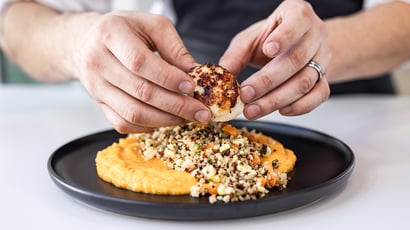What Should Be Done with Surplus Ingredients? Make the Most of Every Bite.
 Let’s be honest: when most people hear “surplus ingredients,” they don’t picture a palate-pleasing lunch. But we do. We see hidden potential in every tray of roasted vegetables, those quirky odds and ends of produce that usually get tossed in the bin, and the leftover bones after carving a chicken. For us, the question isn’t what to do with them — it’s how to turn them into something unexpectedly delicious.
Let’s be honest: when most people hear “surplus ingredients,” they don’t picture a palate-pleasing lunch. But we do. We see hidden potential in every tray of roasted vegetables, those quirky odds and ends of produce that usually get tossed in the bin, and the leftover bones after carving a chicken. For us, the question isn’t what to do with them — it’s how to turn them into something unexpectedly delicious.
Whether it’s turning buttery croissants into indulgent bread pudding or transforming yesterday’s veggies into today’s smoky hummus, our chefs take a culinary-first approach to sustainability. With creativity and care, they breathe new life into ingredients that might otherwise go to waste. The result? Dishes that are full of flavor and feel-good purpose — memorable meals your team will rave about long after lunch.
Culinary creativity meets smart cooking
We believe food should do more than just taste good — it should also do good. Something good for your people and the planet.
This approach to cooking is rooted in instinct and flavor. Some of our chefs collect vegetable trimmings and repurpose them into rich, house-made stock, while others take it a step further by crafting deeply flavored broths from leftover vegetables and bones. One even creates a showstopping fish head soup using the parts left over after preparing fish for the grill — a crowd favorite that proves the whole fish can be used, honored and savored.
We’ve also seen incredible innovation with fermentation and fruit preservation. When one team developed a series of custom shrub flavors, the leftover fruit didn’t go to waste — it was transformed into a “spent” fruit jam, layered into grab-and-go yogurt parfaits for an unexpected touch of sweetness. Over in the bakery, nut and veggie milk pulp finds new life in cookies and quick breads, adding moisture, texture and a touch of extra protein.
This is what smart cooking looks like — creative, intuitive and always flavor-first. It’s how we reduce food waste, rethink how to use surplus ingredients and still deliver standout meals every day. And it’s how we create menus that are bold, consider trends, and in tune with the seasons.
Flavor, not compromise
Resourceful doesn’t have to mean boring. In fact, it’s where some of our most exciting ideas begin. Our menus shift with what’s available, bringing out the best in every ingredient. And when fruit or produce doesn’t meet visual standards? That’s no reason to discard it. We’ve seen imperfect fruits turned into veggie chips, nutrient-packed smoothies, and jams — each one extending the life of the ingredient while delivering something new and worth thinking about.
Even the odds and ends — like peelings once tossed aside — can become something exciting, such as a house-made vegetable ash salt that adds a complex, savory punch to roasted vegetables.
It’s a strategy, not an afterthought. a fresh, chef-forward mindset that brings creativity and sustainability to every dish. One that not only answers the question of what should be done with surplus ingredients, but inspires a new way of thinking when it comes to cooking. With surplus ingredients, why not shake things up? Add a new vegetable into a fan-favorite dish. Try a new blend of herbs. Leftovers may just lead to discovering new depths of delicious!
Good for the planet, better for the workplace
By minimizing waste and making the most of every ingredient, we help companies like yours meet their environmental preservation goals in ways that feel authentic and engaging. Its sustainability served.
Reducing food waste also supports your bottom line. Fewer ingredients lost means better cost control, less overproduction and more efficient operations — all without compromising the dining experience. And when your food program reflects your values — like innovation and corporate environmental responsibility — your people notice. It shows you care not just about what’s on their plates, but about how it got there.
Corporate environmental responsibility that’s crave-worthy
Our passionate chefs turn those surplus ingredients into delicious proof that creativity and sustainability belong in every workplace menu. Because when your food is chef-crafted with intention and full of flavor, you truly make the most of every bite.
Ready to bring a smarter, more sustainable food experience to your workplace? Let’s talk.